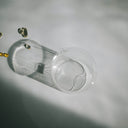An M-shaped hairline is a natural yet often misunderstood feature that many people notice in their reflection.
Is it just part of your hairline's natural shape, or could it signal something more, like hair loss?
This article will help you spot an M-shaped hairline, understand what causes it, and explore simple styling tips and treatment options to feel confident about your look.
Table of content
What is an M-shaped hairline?
An M-shaped hairline is a hairline pattern where the hair recedes at the temples while remaining prominent in the center, forming an "M" shape. It’s commonly associated with male pattern baldness, but it can also simply be a mature hairline.
This type of hairline can develop naturally as you age, often starting in your late teens or early twenties.
While the resemblance to a widow’s peak can cause confusion, the key difference lies in the corners of the forehead—an M-shaped hairline has more pronounced temple recession.
Whether it's a sign of balding depends on other factors like genetics, age, and hormonal influences.
As your leading source for hair health information over the past 4 years, we never compromise on accuracy. When it comes to your health, you deserve information you can truly rely on - and earning your trust is our top priority.
Here's how Scandinavian Biolabs ensures every piece of content meets the highest standards of accuracy and integrity:
- Credentialed Experts: Our reviewers are actively practicing doctors and medical researchers
- Stringent Reviews: Content undergoes rigorous editing by subject specialists and review by a practicing doctor.
- Evidence-Based: We rely on well-established research from trusted scientific sources like peer-reviewed journals and health authorities.
- Full Transparency: Our editorial standards, writer credentials, reviewer credentials, correction process, and funding are all publicly documented.
- Independent Voice: While we do promote products, we operate in a vacuum to business operations. Our main goal is just an unwavering commitment to providing medically-sound guidance.
You can count on Scandinavian Biolabs to consistently deliver the trustworthy health information you deserve. Read our Editorial Standards.
Common causes of an M-shaped hairline
An M-shaped hairline usually happens because of a mix of genetics, hormones, and lifestyle factors. Here are the most common reasons:
- Genetics: If family members have an M-shaped hairline or male pattern baldness, it could be hereditary.
- Hormones: DHT (dihydrotestosterone) binds to hair follicles, shrinking them and leading to hairline changes.
- Stress: Chronic stress disrupts the hair growth cycle and can trigger hair loss.
- Aging: Hairline changes are a natural part of aging, especially for men after puberty.
- Diet: Poor nutrition or restrictive diets can impact hair health over time.
How to identify an M-shaped hairline
Noticing temple recession or changes in your hairline? Here’s how to spot if you have an M-shaped hairline:
- Stand in front of a mirror in bright light.
- Look at the corners of your forehead. If the hair is thinning or receding there while remaining prominent in the center, this could indicate an M-shaped hairline.
- Use your fingers to trace the hairline shape. If it forms an "M," that’s a clear sign.
- Compare old photos of yourself to check for recent changes.
- Consult a dermatologist or trichologist if you’re unsure or concerned.
Does an M-shaped hairline mean hair loss?

An M-shaped hairline doesn’t always mean you’re losing hair. Sometimes, it’s just part of a natural, maturing hairline. However, it can also signal early-stage male pattern baldness.
Hair loss caused by male pattern baldness happens when DHT affects the hair follicles, leading to gradual thinning. If your hairline recedes more deeply over time or is accompanied by thinning at the crown, it might be worth seeking professional advice.
It’s also possible to have a temporary M-shaped hairline due to stress or nutritional deficiencies. Addressing these factors can often stop further changes and sometimes even reverse minor hair loss.
Styling tips to manage an M-shaped hairline
Changing how you style your hair can make a big difference in how your hairline looks. Here are a few ideas:
- Buzz cut: Keeping your hair super short minimizes contrast with receding areas.
- Textured crop: Styling your hair forward can create a fuller, even look.
- Fringe: Long bangs or a fringe can cover up the hairline entirely.
- Side part: Parting your hair deeply to one side can draw attention away from thinning areas.
- Pompadour: Slicking your hair back gives the illusion of volume at the hairline.
These styles aren’t just practical—they’re also trendy and versatile. A skilled barber or stylist can help you find the look that works best for your face shape and hair texture.
M-shaped hairline vs. a widow’s peak
An M-shaped hairline and a widow’s peak may look similar at first glance, but they’re distinct in shape and what they indicate. An M-shaped hairline forms a sharper triangular pattern on the sides with a prominent central section, often associated with hair loss.
In contrast, a widow’s peak curves gently up the sides and dips into a central point without the pronounced recession seen in an M-shaped hairline.
While a widow’s peak is typically a natural genetic trait and not a sign of hair loss, an M-shaped hairline could be an early indicator of male pattern baldness.
The corners of the forehead are the key areas to observe—if they’re receding noticeably, it’s likely an M-shaped hairline rather than a widow’s peak.
Knowing this distinction can help you understand whether your hairline is just unique or if it’s time to consider hair care options.
Maturing hairline vs. receding hairline
A maturing hairline is a normal part of aging, but it’s often confused with a receding hairline. The main difference? A maturing hairline settles into a new position and stays there, while a receding hairline continues to move back over time.
Typically, a maturing hairline shows slight changes, with minimal recession around the temples. On the other hand, a receding hairline caused by male pattern baldness can retreat more than 1.5 cm and may leave noticeable thinning or bald spots.
For women, a receding hairline is much rarer, so any significant changes should be evaluated by a professional to rule out underlying conditions.
How to fix an M-shaped hairline
Feeling self-conscious about an M-shaped hairline? The good news is that there are ways to manage or even improve it. Start by experimenting with hairstyles that draw attention away from the hairline or make it less noticeable:
- Shave your head to even out thinning areas.
- Style your hair in a sleek pompadour, side-swept look, or caesar cut.
- Use a fringe to cover the hairline for longer hair.
- Create a deep side part for a stylish and flattering look.
If you’re looking to regrow or maintain hair, several treatments are available. Medications like Finasteride and Dutasteride reduce the hormone DHT that causes hair loss, though these are not suitable for female pattern baldness.
Minoxidil is another option—it’s a topical solution that stimulates blood flow to the scalp and can be used by both men and women.
One innovative product to consider is Bio-Pilixin Activation Serum. This clinically tested serum is drug-free and developed with plant growth factors derived from stem cell technology.

It supports hair follicles and encourages growth:
- Clinically tested results: 93% of participants in trials experienced reduced hair loss within 150 days.
- Measurable benefits: 77% saw reduced hair shedding after just 45 days, while 73% had increased hair density after five months.
The serum is safe for daily use and is designed to fit seamlessly into your routine.
Many users notice reduced hair loss, like fewer strands in the shower, within weeks. It’s a simple way to nurture your scalp and take proactive steps toward healthier hair.
Conclusion
An M-shaped hairline can be a natural part of aging or an early sign of hair loss.
By understanding the causes and recognizing the difference between maturing and receding hairlines, you can better decide how to manage or treat it.
From styling tips to medications and innovative products, there are plenty of options to suit your goals and preferences.
If you’re ready to take the next step, try Bio-Pilixin Activation Serum for a safe, effective way to support hair growth.
Backed by science and loved by users, it could be just the thing to help you feel great about your hairline again.
References:
-
https://my.clevelandclinic.org/health/diseases/16921-hair-loss-in-women
-
https://www.americanhairloss.org/men_hair_loss/introduction.html





